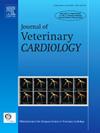犬主动脉瓣狭窄的超声心动图分类:一种新的分期系统的潜在效用。
IF 1.3
2区 农林科学
Q2 VETERINARY SCIENCES
引用次数: 0
摘要
人类主动脉瓣狭窄(AS)的严重程度使用基于二维超声心动图变化的分期系统进行分类,该分期系统考虑了整体心脏损伤的程度。目前,犬AS的分类仅基于经主动脉压力梯度(PG)。本研究旨在基于适应的人类分期系统对AS犬进行回顾性分类,探索分类的可行性以及分期与PG和临床体征等特征之间的关系。动物:这项研究包括87只客户养的狗。材料和方法:从计算机记录中检索临床和超声心动图数据。根据改进的人类分期系统(分期:0/1/2+)对犬进行分类。研究了描述性统计。使用适当的统计检验评估分期之间信号、PG和临床体征的差异。如果结果:41只狗被划分为0期,36只被划分为1期,10只被划分为2+期,则确定了意义。在不同阶段之间没有发现信号或重量的差异。2+期犬比0期或1期犬更容易出现临床症状(分别为50%对7% [P=0.004]和17% [P=0.043]), PG高于0期犬(90 mmHg [35-143 mmHg]对25 mmHg [18-182 mmHg], P=0.001)。结论:本研究提出了一种对AS犬进行分类的替代方法。数据支持进一步研究分期系统,以比较这种分类是否比单独评估PG有额外的价值。本文章由计算机程序翻译,如有差异,请以英文原文为准。
Echocardiographic classification of dogs with aortic stenosis: potential utility of a novel staging system
Introduction
Severity of aortic stenosis (AS) in humans is classified using a staging system based on two-dimensional echocardiographic changes, which considers the extent of global cardiac damage. Currently, classification of canine AS is based on trans-aortic pressure gradient (PG) alone. This study aimed to retrospectively classify dogs with AS based on an adapted human staging system, exploring feasibility of classification and the association between stage and features such as PG and clinical signs.
Animals
This study included 87 client-owned dogs.
Materials and methods
Clinical and echocardiographic data were retrieved from computerised records. Dogs were classified according to a modified human staging system (stages: 0/1/2+). Descriptive statistics were explored. Differences in signalment, PG, and clinical signs between stages were evaluated using appropriate statistical tests. Significance was identified if P<0.05 after correction for multiple comparisons.
Results
Forty-one dogs were classified as stage 0, 36 as stage 1, and 10 as stage 2+. No difference in signalment or weight was identified between stages. Dogs classified as stage 2+ were more likely to have clinical signs than those in stages 0 or 1 (50% vs. 7% [P=0.004] and 17% [P=0.043], respectively) and had a higher PG than dogs in stage 0 (90 mmHg [35–143 mmHg] vs. 25 mmHg [18–182 mmHg], P=0.001).
Conclusions
This study presents an alternative way to classify dogs with AS. Data support further study of the staging system to compare whether or not this classification has additional value over assessment of PG alone.
求助全文
通过发布文献求助,成功后即可免费获取论文全文。
去求助
来源期刊

Journal of Veterinary Cardiology
VETERINARY SCIENCES-
CiteScore
2.50
自引率
25.00%
发文量
66
审稿时长
154 days
期刊介绍:
The mission of the Journal of Veterinary Cardiology is to publish peer-reviewed reports of the highest quality that promote greater understanding of cardiovascular disease, and enhance the health and well being of animals and humans. The Journal of Veterinary Cardiology publishes original contributions involving research and clinical practice that include prospective and retrospective studies, clinical trials, epidemiology, observational studies, and advances in applied and basic research.
The Journal invites submission of original manuscripts. Specific content areas of interest include heart failure, arrhythmias, congenital heart disease, cardiovascular medicine, surgery, hypertension, health outcomes research, diagnostic imaging, interventional techniques, genetics, molecular cardiology, and cardiovascular pathology, pharmacology, and toxicology.
 求助内容:
求助内容: 应助结果提醒方式:
应助结果提醒方式:


